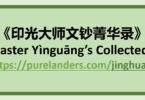上成佛道,下化众生,成始成终之法门
[5] [The] Dharma Door That Accomplishes [The] Buddha Path Above [And] Transforms Sentient Beings Below, That Accomplishes [In The] Beginning [And] Accomplishes [In The] End
大觉世尊,愍诸众生,迷背自心,轮回六道,久经长劫,莫之能出。由是兴无缘慈,运同体悲,示生世间,成等正觉,随顺机宜,广说诸法。
[The] Great Awakened World-Honoured [One, has] sympathy [for] all sentient beings, [with] confusions contradicting [their] own minds, [who are] reborn [in the] six paths, extending [and] passing long kalpas, [becoming] those not able [to] exit. Due [to] this, [he] gave rise [to] unconditioned loving-kindness, used [the] same body’s compassion, manifested birth [in the] world, accomplished Equal Right Awakening, [and] accordingly complying [with their] capacities suitably, widely spoke all Dharma [doors].
[Note 1: The six paths (六道) are the (i) hell-beings’ path (地狱道), (ii) hungry ghosts’ path (饿鬼道), (iii) animals’ path (畜生道), (iv) human beings’ path (人道), (v) asuras’ path (阿修罗道) and (vi) heavenly beings’ path (天道). Unconditioned loving-kindness (无缘慈) is the wish for all to be well and happy, even if they have little or no karmic affinity with one. To use the same body’s compassion (运同体悲) is to remove suffering from others as it they are parts of one’s own body. Equal Right Awakening (等正觉) is Buddhahood (佛果).]
括举大纲,凡有五宗。五宗维何?曰律、曰教、曰禅、曰密、曰净。律者佛身,教者佛语,禅者佛心。佛之所以为佛,唯此三法。佛之所以度生,亦唯此三法。
Including [and] raising [their] main points [i.e. hawser], all have [the] Five Traditions. [These] Five Traditions [are] connected [by] what? [They are] called [the] Vinaya, called Teachings, called Chán, called Esoteric, [and] called Pure Land. That Vinaya [is the] Buddha’s body, those Teachings [are the] Buddha’s speech, [and] that Chán [is the] Buddha’s mind. Those by which [the] Buddhas become Buddhas, [are] only [with] these three Dharma [doors]. Those by which [the] Buddhas deliver sentient beings, [are] also only [with] these three Dharma [doors].
[Note 2: The key Five Traditions (五宗) are the Vinaya, Teachings, Chán, Esoteric and Pure Land (律教禅密净) traditions. Briefly, the (i) Vinaya Tradition (律宗) focuses on strict upholding of the precepts (持戒), to purify the three karmas (三业) of body, speech and mind. The (ii) Teachings Tradition (教宗) focuses on studying the sūtras’ teachings (经教), to rely on their teachings to cultivate contemplation (依教修观). The (iii) Chán Tradition (禅宗) focuses on Self-powered (自力) meditation (禅修) to see one’s nature (见性). The (iv) Esoteric Tradition (密宗) focuses on forming of mudrās (结印), upholding of mantras (持咒) and visualisations (观想), to empower the three samayas (mysteries) (三密加持) of body, speech and mind. The (v) Pure Land Tradition (净土宗) focuses on the Practice (行) of mindfulness of Buddha (念佛), with profound Faith (深信) and sincere Aspiration (切愿), for reaching his Pure Land, to most swiftly expedite progress to Buddhahood for one and all.]
众生果能依佛之律、教、禅以修持,则即众生之三业,转而为诸佛之三业。三业既转,则烦恼即菩提,生死即涅槃矣。
Sentient beings, if able [to] rely [on the] Vinaya, Teachings [and] Chán of [the] Buddha, with [them for] practice, then immediately, [will the] three karmas of sentient beings, transform and become [the] three karmas of all Buddhas. [With the] three karmas since transformed, then [are] afflictions immediately Bodhi, [and the cycle of] birth [and] death immediately Nirvāṇa.
[Note 3: To practise the Dharma is to align with the Buddhas. The meaning of both Bodhi (菩提) and Nirvāṇa (涅槃) is awakening (觉悟).]
又恐宿业障重,或不易转,则用陀罗尼三密加持之力,以熏陶之。若蜾蠃之祝螟蛉,曰「似我似我」,七日而变成蜾蠃矣。
Also fearing [that their] past karmic obstacles [are] heavy, perhaps not easy [to] transform, then using dhāraṇīs’ power of [the] three samayas’ [i.e. mysteries] empowerment, with [it] nurturing them. If [a] wasp who prays [to a] green insect says, ‘Like me, like me’, [in] seven days, [he] then changes [to] become [a] wasp.
[Note 4: Dhāraṇīs (陀罗尼) are usually longer mantras (咒语) practised by recitation, more frequently in the Esoteric Tradition. They encapsulate and express the essence of the Dharma, as words and their sounds. The principle of repeating ‘Like me, like me’, is similar to that of those who are continually mindful of Buddha eventually (meeting Buddhas, learning from Buddhas and) becoming Buddhas.]
又恐根器或劣,未得解脱,而再一受生,难免迷失。于是特开信愿念佛,求生净土一门,俾若圣若凡,同于现生,往生西方。
Also fearing [that those with] root capacity perhaps inferior, yet [to] attain liberation, [will] then again, once receiving birth, [have] difficulties avoiding [becoming] confused [and] lost. Thereupon, specially opening [with] Faith [and] Aspiration [being] mindful [of the] Buddha, seeking birth [in his] Pure Land, [this] one door, so that if [as] noble [beings] or ordinary [beings, they can] together in [this] present life, [be] reborn [in the] Western [Pure Land].
[Note 5: As this is already the Dharma-Ending Age (末法时期), with the quality of Dharma practitioners in general decline, it is safer to think we are these beings with inferior root capacity (劣根器). Thus should we learn and practise the Pure Land path.]
圣则速证无上菩提,凡则永出生死系缚。以其仗佛慈力,故其功德利益,不可思议也。
Noble [beings will] then quickly realise unsurpassable Bodhi, [and] ordinary [beings will] then forever exit [from] fetters [of the cycle of] birth [and] death. With them relying [on the] Buddha’s loving-kindness’ power, thus [will] their meritorious virtues’ benefits [be] inconceivable.
[Note 6: Unsurpassable Bodhi (无上菩提) is Buddhahood.]
须知律为教禅密净之基址,若不严持禁戒,则教禅密净之真益莫得。如修万丈高楼,地基不固,则未成即坏。
[It] should [be] known [that the] Vinaya [is] as [the] foundation [of the] Teachings, Chán [and] Esoteric [Traditions]. If not strictly upholding [the] prohibitive precepts, then [will] true benefits of [the] Teachings, Chán, Esoteric [and] Pure Land [Traditions] not [be] attained. Like building [a] ten thousand zhàngs’ high tower, [if the] ground’s foundation [is] not firm, then [when] yet [to be] accomplished, [it will] immediately [be] destroyed.
[Note 7: The Threefold Learning (三学) of (i) precepts, (ii) concentration and (iii) wisdom (戒定慧) that lead to liberation of one and all begins with committing to the precepts – to prevent evil and to practise good (止恶行善). As one zhàng (丈) is about 3.33 metres, ten thousand zhàngs is about 33,000 metres.]
净为律教禅密之归宿,如百川万流,悉归大海。以净土法门,乃十方三世诸佛上成佛道,下化众生,成始成终之法门也。
[The] Pure [Land is] as [the] home [to] return [to], of [the] Vinaya, Teachings, Chán [and] Esoteric [Traditions], like [a] hundred rivers [and] ten thousand streams, all return [to the] great ocean. [As] with [the] Pure Land Dharma Door, then [can the] ten directions’ three periods’ all Buddhas accomplish [the] Buddha path above, [and] transform sentient beings below, [it is the] Dharma door that accomplishes [in the] beginning [and] accomplishes [in the] end.
[Note 8: As all have to reach Pure Land on the path to Buddhahood, it is the central home of all Buddhist traditions. The ten directions (十方) refer to all places in all directions, which are the four cardinal directions (of (i) East [东], (ii) South [南], (iii) West [西] and (iv) North [北]), four intermediate directions (of (v) Southeast [东南], (vi) Northeast [东北], (vii) Southwest [西南] and (viii) Northwest [西北]), (ix) below (下) and (x) above (上). The three periods (三世) refer to all time, which are the (i) past period (过去世), (ii) present period (现在世) and (iii) future period (未来世).]
净土宗十三祖印光大师
Pure Land Tradition’s 13th Patriarch Great Master Yìnguāng
《印光法师文钞》(正编):青莲寺念佛宣言书;
Dharma Master Yìnguāng’s Collected Writings (First Compilation): Blue Lotus [i.e. Qīnglián] Monastery’s Mindfulness [Of] Buddha’s Declaration;
印光大师文钞菁华录(第五则):一、赞净土超胜(第五则)
Record [Of] Great Master Yìnguāng’s Collected Writings’ Essence (5th Short Section): 1st [Chapter]: Praise [Of The] Pure Land [Dharma Door Being] Transcendental [And] Supreme (5th Short Section)
[Ref: #5 / 1.5]
Namo Amituofo : Translation and notes by Shen Shi’an
下一部分
Next Part:
大乘经皆说净土妙法
[6] The Great Vehicle’s Sūtras All Speak Of The Pure Land Teachings’ Wonderful Dharma
https://purelanders.com/2022/06/02/6-the-great-vehicles-sutras-all-speak-of-pure-land-teachings-wonderful-dharma
上一部分
Previous Part:
不念佛即念九界
[4] Not Being Mindful Of The Buddha Is To Be Mindful Of The Nine Realms
https://purelanders.com/2022/04/02/4-not-being-mindful-of-the-buddha-is-to-be-mindful-of-the-nine-realms
完整典籍
Complete Text:
《印光大师文钞菁华录》
Record Of Great Master Yìnguāng’s Collected Writings’ Essence
https://purelanders.com/jinghualu




